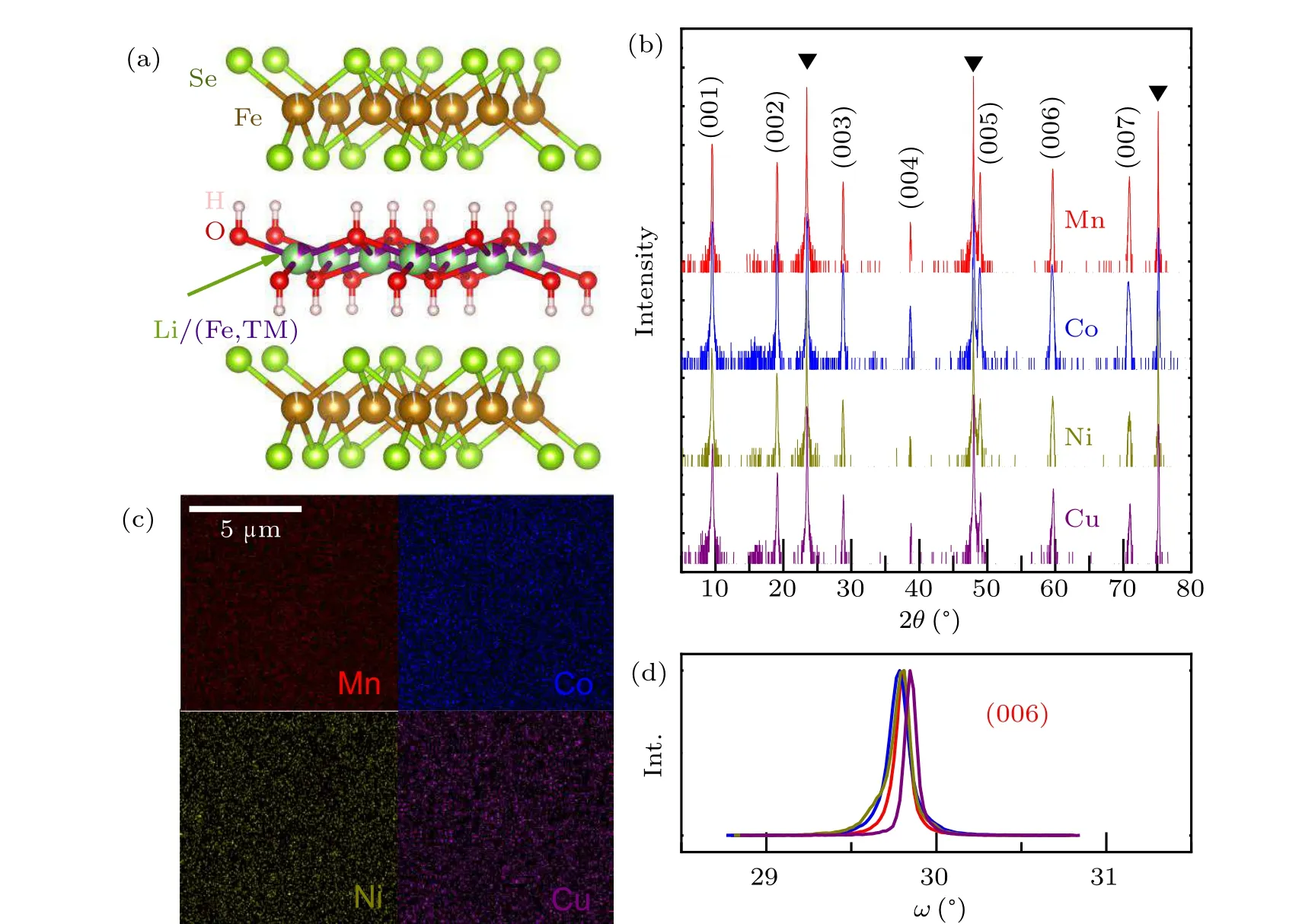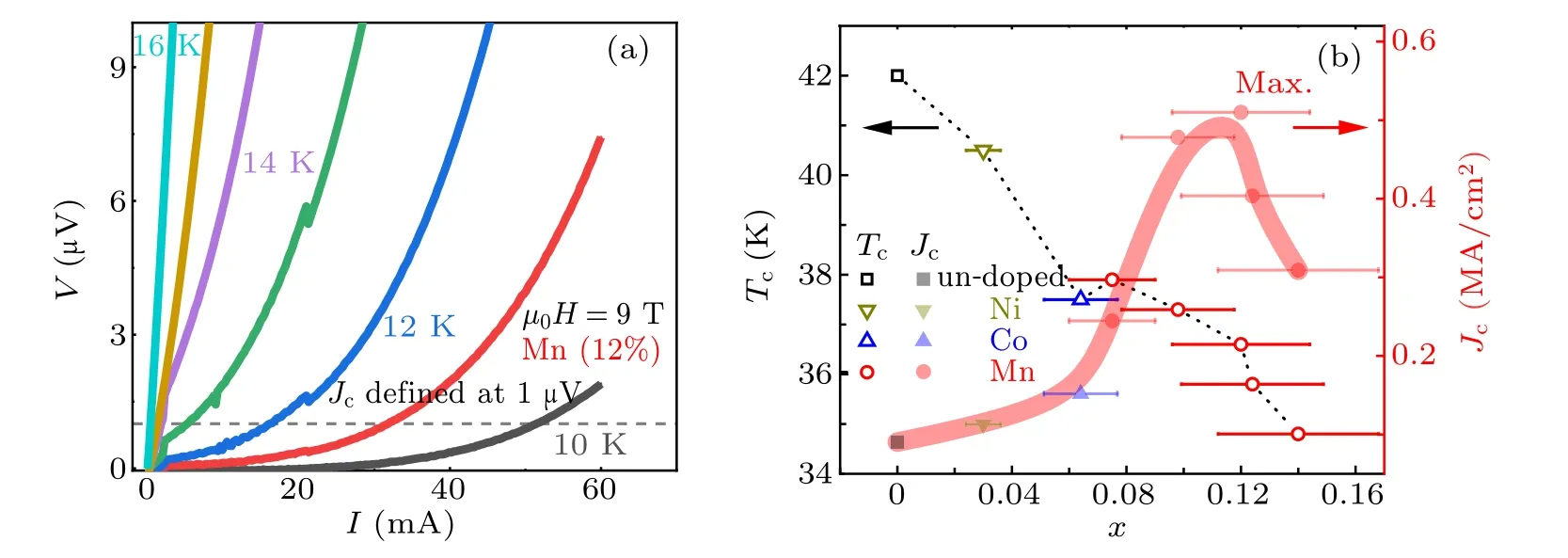Doping effects of transition metals on the superconductivity of(Li,Fe)OHFeSe films*
Dong Li(李栋), Peipei Shen(沈沛沛), Sheng Ma(马晟), Zhongxu Wei(魏忠旭),Jie Yuan(袁洁),3, Kui Jin(金魁),3, Li Yu(俞理),3, Fang Zhou(周放),3,Xiaoli Dong(董晓莉),3,†, and Zhongxian Zhao(赵忠贤),3
1Beijing National Laboratory for Condensed Matter Physics,Institute of Physics,Chinese Academy of Sciences,Beijing 100190,China
2School of Physical Sciences,University of Chinese Academy of Sciences,Beijing 100049,China
3Songshan Lake Materials Laboratory,Dongguan 523808,China
Keywords: iron-based superconductivity,transition metals doping,critical current density
1. Introduction
High-Tc(42 K)FeSe-based compound(Li,Fe)OHFeSe[1]has received extensive attention because of the rich physics in the superconducting (SC) and normal states[2–18]as well as the potential for application.[19–25]The intercalated(Li,Fe)OHFeSe,sharing a similar electronic structure[7,8]with the prototypal FeSe monolayer, exhibits a strong electronic two-dimensionality and a nearly linear magnetic susceptibility extracted for the iron planes,[5]supporting the presence of magnetic fluctuations further evidenced by the inelastic neutron scatterings.[12,13]Recently, the Majorana zero bias mode[20]with quantized conductance plateau[21]is reported in the system. On the other hand, the high-field critical current density (Jc) is observed to be remarkably enhanced by Mn doping.[24]So far most studies are focused on the physics related to the superconducting FeSe layers, with less attention paid on the intercalated (Li,Fe)OH layers. Previous results have shown that the Mn doping can affect the superconducting critical temperature (Tc) to certain extent in the(Li,Fe)OHFeSe single crystals.[26–28]It is desirable to further study the interplay between the interlayer doping of various TMs and the superconductivity in the(Li,Fe)OHFeSe system.
In this work,we aim to investigate the responses of superconducting critical parameters(Tc, Hc2, and Jc)to the doping by the transition metals Mn, Co, Ni, and Cu in the singlecrystalline films of(Li,Fe)OHFeSe. Our results show that the doping of TMs Mn and Co can be achieved more easily than the others by the matrix-assisted hydrothermal epitaxy(MHE)technique[29]that we have developed for the film growth.Both the critical temperature Tcand upper critical field Hc2are observed to be weakly affected by the TM doping,distinctly different from TM-doped binary FeSe where the superconductivity is strongly suppressed.[30–33]It is suggested that the doped TMs mainly occupy the Fe-sites of the intercalated(Li,Fe)OH layers rather than the superconducting FeSe layers. Nevertheless, we find by systematic experiments that, among all the TMs,the Mn dopant can enhance the in-field Jc(9 T,10 K)to a value as high as 0.51 MA/cm2at an optimal doping level of~12%.
2. Experiments
Four transition metals of Mn, Co, Ni, and Cu(purity >99.99%; Alfa Aesar)were chosen to synthesize the doped (Li,Fe)OHFeSe films by the MHE method reported elsewhere.[29]X-ray diffraction (XRD) data of all the samples were collected at room temperature on a 9 kW Rigaku SmartLab x-ray diffractometer equipped with two Ge(220)monochromators. The measurements of scanning electron microscope (SEM) and energy dispersive x-ray spectroscopy(EDS)were performed on a Hitachi SU5000. The SC diamagnetism and electrical resistivity in fields up to 9 T were measured using Quantum Design MPMS-3 and PPMS-9 systems,respectively.
3. Results and discussion
Figure 1(a)is a schematic illustration for the crystal structure of TM-doped (Li,Fe)OHFeSe, formed by an alternative stacking of the FeSe and hydroxide layers. There are two different iron sites likely to accommodate the TM dopants, one in the (Li,Fe)OH interlayers and the other in the FeSe layers. Figure 1(b)shows the XRD characterizations of the four(Li,Fe)OHFeSe films doped with Mn,Co,Ni,and Cu,respectively. All the XRD patterns exhibit a single preferred (00l)orientation. As shown in Fig.1(d),the full width at half maximum(FWHM)of the x-ray rocking curves for the(006)reflection ranges from 0.1◦to 0.2◦, indicating the high crystalline quality of the films. The surface morphology and TM doping level x (relative to the Se content) were characterized by SEM with EDS, respectively. The corresponding EDS mapping images of all the film samples are presented in Fig.1(c).It is obvious that all the incorporated TM elements are homogeneously distributed across the samples without formation of their precipitates.

Fig. 1. (a) A schematic crystal structure of TM-doped (Li,Fe)OHFeSe. (b) XRD patterns of the TMs (Mn, Co, Ni, and Cu) doped(Li,Fe)OHFeSe films. The peaks marked with inverted black triangles are from the LaAlO3 substrates. (c) EDS mapping for the TM elements introduced into the films. (d)The rocking curves of(006)reflection of the TMs doped(Li,Fe)OHFeSe films,with FWHM=0.1◦–0.2◦.
The superconductivity of the TM-doped films is characterized by the field-cooled (FC) magnetization and electrical resistance measurements,as shown in Figs.2(a)and 2(b),respectively.The Tcvalues are determined by the onset temperatures of the diamagnetism.Figure 2(c)summaries the suppression of Tcwith increasing doping level x of the four dopants,with the dashed line indicating the slope S=-0.5 K/%. The higher doping levels achieved for Mn (x up to 13.9%) and Co(6.7%)adjacent to Fe demonstrate that the(Li,Fe)OHFeSe structure accommodates them more easily than Ni(3.5%)and Cu(2.5%). Recent neutron diffraction experiment has shown that the doped Mn exclusively occupies the Fe-sites in the hydroxide layers of deuterated (Li0.875Fe0.062Mn0.062OD)FeSe single crystal.[28]Previous theoretical model calculation has also shown that the electronic structure of (Li,Fe)OHFeSe is hardly affected by the magnetic dopants (Mn, Co) in the interlayers.[34]We note that superconductivity of the TMdoped(Li,Fe)OHFeSe is much less sensitive to the doping than that of the TM-doped binary FeSe superconductors reported previously:[30–33]The superconductivity(with Tc>35 K)still survives in the doped (Li,Fe)OHFeSe films at the highest x levels,sharply contrasting with the cases of Fe1.01-xCuxSe[31]and Fe1-xCoxSe[33]where the superconductivity is killed by the Cu/Co doping of merely 1.5/3.6%.Furthermore,the superconductivity (Tc~44 K) of heavily electron-doped LixFeSe,realized by the solid ionic gating,[35]is also vulnerable to the substitution of 2% Cu for Fe. Therefore it is suggested that the TM dopants are mainly incorporated into the intercalated layers rather than the FeSe layers of the(Li,Fe)OHFeSe films. It is worth mentioning that the present results of the films are different from the previous observations of TMdoped(Li,Fe)OHFeSe single crystals obtained by a hydrothermal ion-exchange method,[5]in which the TM doping into the FeSe layers has been reported.[26,27,36]A possible reason for that is the more limited lattice tolerance of the epitaxial films than the single crystals,due to the presence of substrate in the film growth.
In addition, the upper critical field Hc2extracted from the magneto-transport measurements is also observed to be weakly affected by the TM doping. Three samples(7.5%Mn,6.7% Co, and un-doped) showing similar Tc(~37 K) were deliberately selected for a better comparison of the doping effects. Here the lower Tc(<42 K) of the un-doped film is likely caused by the vacant iron sites of the FeSe layers.[2]Figures 3(a)–3(c)show their temperature dependences of normalized resistance under various magnetic fields along c-axis.The broadening of the resistive transition with magnetic field indicates a weak vortex pinning ability,consistent with previous reports.[24]The Hc2values are extracted from 10%,50%,and 90%normal-state resistance(Rn)chosen at 45 K.As seen in Fig. 3(d), the Hc2(T) curves of the differently doped samples show similar temperature dependences.

Fig. 2. The normalized magnetic (a) and resistance (b) curves near SC transition for the representative doped and un-doped (Li,Fe)OHFeSe films. (c)Tc vs. doping level x for all the(Li,Fe)OHFeSe films. The dashed line indicates the slope S=-0.5 K/%.

Fig.3. The temperature dependences of normalized resistance under various magnetic fields along c-axis for(a)Mn(x=7.5%),(b)Co(6.7%)doped and (c) un-doped (Li,Fe)OHFeSe films. (d) Temperature dependent Hc2 extracted by different criteria for the doped and un-doped samples.

Fig.4. (a)The I–V curves of Mn(12%)doped(Li,Fe)OHFeSe film measured from 16 K to 10 K under 9 T.(b)Tc (open symbols)and Jc at 10 K and 9 T(filled symbols)as functions of x for the doped and un-doped(Li,Fe)OHFeSe films.
Although the TMs introduced into the (Li,Fe)OH layers only weakly affect the Tcand Hc2of the(Li,Fe)OHFeSe system, they can serve as extra pinning centers to improve Jcas previously reported.[24]However,it is uncertain which dopant is the best for enhancing Jcand what is the optimal doping level. These issues vital to possible applications in high field are further studied here. Figure 4(a)shows the representative I–V curves of the 12%Mn-doped film,where Jcis defined at 1 μV.The Jcvalues under the highest magnetic field(9 T)of the PPMS-9 system and the temperature 10 K are compared among different samples. As can be seen from Fig. 4(b), the enhancement of the in-field Jc(9 T,10 K)by the Mn dopant is the strongest among all the TMs,with the optimal Jcachieved at the doping level x=0.12. The non-monotonic evolution of Jccould be explained by two competing factors. Initially,the effect of dopant-induced artificial pinning centers dominates in the intercalated layers,leading to the enhancement of Jcwith increasing x. Then,the effect of Tcsuppression with x becomes more significant, resulting in the declining Jc. Similar non-monotonic evolution of Jchas also been reported in other iron selenide system like Mn-doped FeSe0.5Te0.5.[37]
4. Conclusion
The transition metals of Mn, Co, Ni, and Cu are successfully introduced into the interlayers of the superconducting(Li,Fe)OHFeSe films by the MHE method. We show that the Mn and Co elements are easier to be incorporated into the structure than other transition metals. Our systematic experiments reveal that the Mn doping can enhance Jcof the(Li,Fe)OHFeSe films much more strongly than the other transition metals, with the optimal doping level at ~12%. The TM-doped(Li,Fe)OHFeSe system offers an ideal platform to study the role of the intercalated layers played in the hightemperature superconductivity and its potential application.
- Chinese Physics B的其它文章
- Two-dimensional finite element mesh generation algorithm for electromagnetic field calculation*
- Stable water droplets on composite structures formed by embedded water into fully hydroxylated β-cristobalite silica*
- Surface active agents stabilize nanodroplets and enhance haze formation*
- Synchronization mechanism of clapping rhythms in mutual interacting individuals*
- Theoretical study of the hyperfine interaction constants,Land´e g-factors,and electric quadrupole moments for the low-lying states of the 61Niq+(q=11,12,14,and 15)ions*
- Ultrafast photoionization of ions and molecules by orthogonally polarized intense laser pulses: Effects of the time delay*

